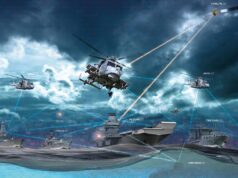Meggitt PLC has secured a £4.2 million contract with BAE Systems for the supply of innovative nose radome technology to enable the effective operation of a pioneering Multi-Function Array radar system on the Typhoon.
The UK has committed to developing new technologies which will equip RAF Typhoons with a “world-leading electronic warfare capability”, in addition to traditional radar functions, including wide band electronic attack.
BAE Systems and Leonardo are on contract to deliver the European Common Radar Systems Mk 2 (ECRS Mk 2) which equips RAF pilots with the ability to locate, identify and suppress enemy air defences using high-powered jamming.
As part of this programme, Meggitt say it has used its advanced composite expertise to design a new higher and broader bandwidth radome to protect the instrumentation from environmental effects, prevent electromagnetic interference whilst being aerodynamically stable and highly transmissive for the AESA radar system’s operational modes.
Chris Allen, President of Meggitt’s Airframe division, said:
“This next generation radar will provide game-changing capabilities to the Typhoon. Our Stevenage facility is a specialist site for this class of cutting-edge radome development and manufacture. We are so proud to be associated with this programme, working with BAE Systems and Leonardo to meet the future ongoing operational needs of the RAF.”














How about basing the system on a miniturised Aegis radar system. That should work
All these articles always boast “world leading” or “most advanced.” Big claims considering none of this stuff is actually operational…..
It’s always marketing isn’t it. When it comes to the military no one wants to hear that its the second or third best equipment in the world.
Realistically this will be as good or better than the current generation of Radar operated by the US but by the time it is operational I’m sure the will be introducing their own next generation tech.
AESA radar will be fitted ….one day in the future.
Always seems to be a lot of articles on it but slow progress in its roll out
They have taken their time on this, that said, the heart of the system (transmit/receive modules and data processing) should be well ahead of F35, after all these elements have been developed ‘years’ after F35 Avionics were finalised and should take advantage of rabidly developing digital technology.
It should be highly capable indeed, considering the large potential dish allowing a large number of modules and swish plate technology allowing a very wide field of view.
If they get this tech right, our Typhoons should be able to kill anything out there well into the late 2030’s, especially mating an extremely advanced radar, incorporating electronic attack, along with upgraded ASRAAM and Meteor, SPEAR, new advanced precision strike bomb kits and a Storm Shadow replacement.
We just need them in sufficient numbers….